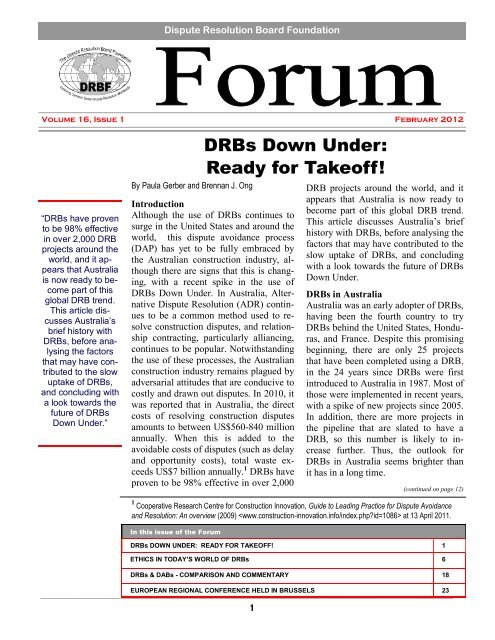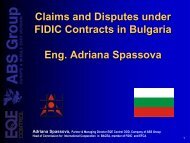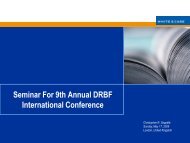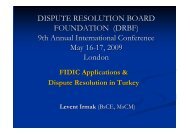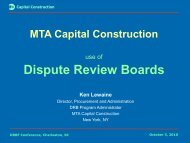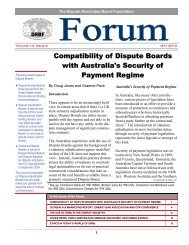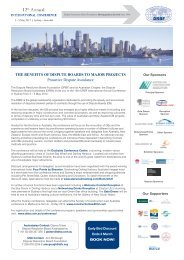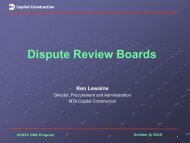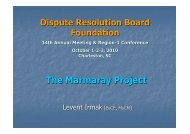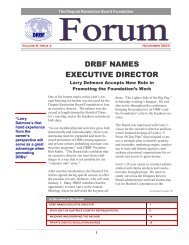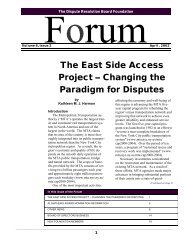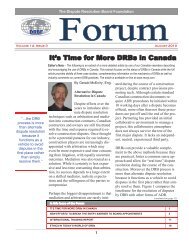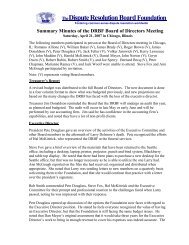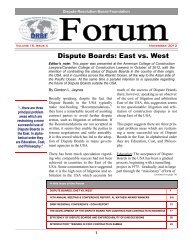DRBs Down Under - Dispute Resolution Board Foundation
DRBs Down Under - Dispute Resolution Board Foundation
DRBs Down Under - Dispute Resolution Board Foundation
Create successful ePaper yourself
Turn your PDF publications into a flip-book with our unique Google optimized e-Paper software.
<strong>Dispute</strong> <strong>Resolution</strong> <strong>Board</strong> <strong>Foundation</strong><br />
Volume 16, Issue 1 February 2012<br />
“<strong>DRBs</strong> have proven<br />
to be 98% effective<br />
in over 2,000 DRB<br />
projects around the<br />
world, and it appears<br />
that Australia<br />
is now ready to become<br />
part of this<br />
global DRB trend.<br />
This article discusses<br />
Australia’s<br />
brief history with<br />
<strong>DRBs</strong>, before analysing<br />
the factors<br />
that may have contributed<br />
to the slow<br />
uptake of <strong>DRBs</strong>,<br />
and concluding with<br />
a look towards the<br />
future of <strong>DRBs</strong><br />
<strong>Down</strong> <strong>Under</strong>.”<br />
By Paula Gerber and Brennan J. Ong<br />
<strong>DRBs</strong> <strong>Down</strong> <strong>Under</strong>:<br />
Ready for Takeoff!<br />
Introduction<br />
Although the use of <strong>DRBs</strong> continues to<br />
surge in the United States and around the<br />
world, this dispute avoidance process<br />
(DAP) has yet to be fully embraced by<br />
the Australian construction industry, although<br />
there are signs that this is changing,<br />
with a recent spike in the use of<br />
<strong>DRBs</strong> <strong>Down</strong> <strong>Under</strong>. In Australia, Alternative<br />
<strong>Dispute</strong> <strong>Resolution</strong> (ADR) continues<br />
to be a common method used to resolve<br />
construction disputes, and relationship<br />
contracting, particularly alliancing,<br />
continues to be popular. Notwithstanding<br />
the use of these processes, the Australian<br />
construction industry remains plagued by<br />
adversarial attitudes that are conducive to<br />
costly and drawn out disputes. In 2010, it<br />
was reported that in Australia, the direct<br />
costs of resolving construction disputes<br />
amounts to between US$560-840 million<br />
annually. When this is added to the<br />
avoidable costs of disputes (such as delay<br />
and opportunity costs), total waste exceeds<br />
US$7 billion annually. 1 <strong>DRBs</strong> have<br />
proven to be 98% effective in over 2,000<br />
DRB projects around the world, and it<br />
appears that Australia is now ready to<br />
become part of this global DRB trend.<br />
This article discusses Australia’s brief<br />
history with <strong>DRBs</strong>, before analysing the<br />
factors that may have contributed to the<br />
slow uptake of <strong>DRBs</strong>, and concluding<br />
with a look towards the future of <strong>DRBs</strong><br />
<strong>Down</strong> <strong>Under</strong>.<br />
<strong>DRBs</strong> in Australia<br />
Australia was an early adopter of <strong>DRBs</strong>,<br />
having been the fourth country to try<br />
<strong>DRBs</strong> behind the United States, Honduras,<br />
and France. Despite this promising<br />
beginning, there are only 25 projects<br />
that have been completed using a DRB,<br />
in the 24 years since <strong>DRBs</strong> were first<br />
introduced to Australia in 1987. Most of<br />
those were implemented in recent years,<br />
with a spike of new projects since 2005.<br />
In addition, there are more projects in<br />
the pipeline that are slated to have a<br />
DRB, so this number is likely to increase<br />
further. Thus, the outlook for<br />
<strong>DRBs</strong> in Australia seems brighter than<br />
it has in a long time.<br />
(continued on page 12)<br />
1 Cooperative Research Centre for Construction Innovation, Guide to Leading Practice for <strong>Dispute</strong> Avoidance<br />
and <strong>Resolution</strong>: An overview (2009) at 13 April 2011.<br />
In this issue of the Forum<br />
<strong>DRBs</strong> DOWN UNDER: READY FOR TAKEOFF! 1<br />
ETHICS IN TODAY’S WORLD OF <strong>DRBs</strong> 6<br />
<strong>DRBs</strong> & DABs - COMPARISON AND COMMENTARY 18<br />
EUROPEAN REGIONAL CONFERENCE HELD IN BRUSSELS 23<br />
———————————————————————————————————————————————————<br />
1
<strong>Foundation</strong> Forum<br />
Dear Members, Supporters and Friends of the DRBF,<br />
I wish that you had a good start into the New Year 2012 and that it will be a good<br />
year for all of us.<br />
The year 2012 is expected by many with great anxiety: the Maya Calendar as well as Nostradamus’<br />
prophecies give a pessimistic outlook for the very end of the year. Whatever one’s personal attitude<br />
towards such visions may be, it shall not be reason for relaxing in active support of our cause.<br />
On 17/18 November 2011 the European Regional Conference took place in Brussels, Belgium under the<br />
headline:<br />
The Use of <strong>Dispute</strong> <strong>Board</strong>s on Large Construction Projects<br />
(Advantages of Successful <strong>Dispute</strong> Avoidance and <strong>Resolution</strong>)<br />
This conference was held in Brussels, the capital of the European Union, in order to bring awareness of<br />
the DB process to the European Commission and its Investment and Development Banks. The conference<br />
was started with an inspiring Keynote Address by the US Ambassador to the Kingdom of Belgium,<br />
Mr. Howard Gutman, while the first day focused on:<br />
Introduction to <strong>Dispute</strong> <strong>Board</strong>s<br />
Practical Application of <strong>Dispute</strong> <strong>Board</strong>s<br />
<strong>Dispute</strong> Avoidance<br />
And<br />
Expectations from Employers, Contractors and Supervising Engineers<br />
The second day was assigned to:<br />
President’s Page<br />
Information on the EU Commission’s and the Investment and<br />
Development Banks’ requirements, policies and activities;<br />
As well as on:<br />
Legal aspects of DBs, DB decisions and the possibilities of their enforcement.<br />
The conference was very well attended by more than 90 delegates. The overall ratings from the evaluation<br />
forms was very positive, with 75% rating their conference appreciation "very good" to "excellent."<br />
For some the enforcement aspect was a bit overstretched, but in the international field (DRBF Region 2)<br />
it is an important issue. (See the full conference report on page 22.)<br />
I would hereby like to express my gratitude to organizers and helpers. You did a very good job.<br />
The beginning of the year started with <strong>Dispute</strong> <strong>Board</strong> Dissemination Seminars in Vietnam and Sri Lanka,<br />
organized and financed by JICA, the Japanese International Cooperation Agency with the aim to spread<br />
knowledge and acceptance of the DB concept within the governments and organizations involved in projects<br />
receiving JICA financing.<br />
———————————————————————————————————————————————————<br />
2
DISPUTE<br />
RESOLUTION<br />
BOARD FOUNDATION<br />
FOUNDERS<br />
R. M. Matyas<br />
A.A. Mathews<br />
R.J. Smith<br />
P.E. Sperry<br />
DISPUTE<br />
RESOLUTION<br />
BOARD FOUNDATION<br />
CHARTER MEMBERS<br />
Jack Alkire, Esq.<br />
Romano Allione<br />
Rodney D. Aschenbrenner<br />
Balfour Beatty Construction. Inc.<br />
S.H. Bartholomew, Inc.<br />
John Beyer<br />
Roger Brown<br />
William C. Charvat AIA<br />
Frank Coluccio Construction Co.<br />
Dillingham Construction, Inc.<br />
Raymond J. Dodson, Inc.<br />
James P. Donaldson<br />
Peter M. Douglass, Inc.<br />
Paul Eller & Associates<br />
Frontier-Kemper Constructors. Inc.<br />
Steven M. Goldblatt<br />
Granite Construction, Inc.<br />
Guy F. Atkinson Co. of California<br />
Greg M. Harris, Esq.<br />
Paul R. Heather<br />
Impregilo SPA<br />
Gordon L. Jaynes, Esq.<br />
Al Johnson Construction Co.<br />
Keating Associates<br />
Thomas R. Kuesel<br />
Kerry C. Lawrence<br />
Kellogg, LLC<br />
Kiewit Construction Group Inc.<br />
Lemley & Associates, Inc.<br />
Al Mathews Corporation<br />
McNally Tunneling Corporation<br />
Mechanical Contractors Association<br />
of Westem Washington<br />
Meyer Construction Consulting<br />
Mole Constructors, Inc.<br />
Nadel Associates<br />
Stephen J. Navin<br />
John W. Nichols, P.E.<br />
Parsons Brinckerhoff Quade &<br />
Douglas, Inc.<br />
Pease & Sons<br />
Edward W. Peterson<br />
H. Ray Poulsen Jr.<br />
Quadrant II lnc.<br />
John Reilly Associates<br />
Aurthur B. Rounds<br />
Seifer Yeats & Mills L.L.P.<br />
Shannon & Wilson, Inc.<br />
J.F. Shea Co., Inc.<br />
Patrick A. Sullivan, Esq.<br />
Traylor Brothers, Inc.<br />
<strong>Under</strong>ground Technology Research<br />
Council<br />
Watt, Tieder & Hoffar, L.L.P.<br />
James L. Wilton<br />
Woodward-Clyde Consultants<br />
Ed Zublin AG<br />
<strong>Foundation</strong> Forum<br />
JICA had invited the DRBF to assist in the seminars. Toshihiko Omoto and I were<br />
involved in Vietnam and Sri Lanka. Two future seminars will be held in the Philippines<br />
and in Indonesia, where Sebastian Hök will accompany Toshihiko.<br />
I would like to commend JICA and its representatives for the valuable effort and<br />
thank them for inviting us to participate.<br />
The seminars and surrounding meetings were very well attended. The importance<br />
and the standing of JICA brought many more owners’ representatives to the audiences<br />
than we have at other events.<br />
Increased awareness will lead to more application of the DB process and in consequence<br />
an increased need for first class DB members, such as the DRBF offers.<br />
Let me inform you on a change in the Chair of the Manual Committee: Joe Sperry<br />
has asked to be released from that position, and Dan Meyer has agreed to take over<br />
the important duty. Joe's leadership of the committee dates back over six years,<br />
when the committee first formed and created the current Manual. I would like to<br />
thank Joe for his work for our Manual, making it into a most helpful and appreciated<br />
tool for users and <strong>Dispute</strong> <strong>Board</strong> members; and Dan for his future commitment.<br />
Let me conclude with reminding you of the upcoming conferences and workshops:<br />
February 16-17, Lusaka, Zambia<br />
May 3-5, Sydney, Australia<br />
May 31, Seattle, Washington, USA<br />
September 28-30, New York, NY, USA<br />
Besides the most interesting topics, these give the opportunity to meet each other,<br />
discuss and enjoy the DRBF community.<br />
Volker Jurowich<br />
President<br />
DRBF Executive <strong>Board</strong> of Directors<br />
———————————————————————————————————————————————————<br />
3
<strong>Foundation</strong> Forum<br />
Executive <strong>Board</strong> of Directors<br />
The members of the Executive <strong>Board</strong> of Directors are:<br />
Volker Jurowich, President<br />
Roger Brown, President Elect<br />
John C. Norton, Immediate Past President<br />
Murray Armes, Secretary<br />
James P. Donaldson, Treasurer<br />
Doug Holen, Director and President, Region 1 <strong>Board</strong><br />
Richard Appuhn, Director and President, Region 2 <strong>Board</strong><br />
Romano Allione, Past President<br />
James J. Brady, Past President<br />
Peter M. Douglass, Director, Past President<br />
Gwyn Owen, Director, Past President<br />
Joe Sperry, PE, Founder, Honorary Director<br />
The Executive Committee meets monthly. Recent topics have included:<br />
● Creation of a Policy & Procedures Manual for internal governance.<br />
● Upcoming conferences and training workshops.<br />
● Expansion of the process to new markets.<br />
Summaries of the Executive <strong>Board</strong> meetings are available to all DRBF members on<br />
the DRBF web site. To access the <strong>Board</strong> of Directors Meeting Minutes Summary,<br />
go to www.drb.org. Click on the Member Login button, and then click on DRBF<br />
<strong>Board</strong> of Directors.<br />
Executive <strong>Board</strong> of Directors Meeting Schedule:<br />
February 17, 2012 by conference call<br />
March 16, 2012 by conference call<br />
April 20, 2012 by conference call<br />
The <strong>Board</strong>s of Regions 1 and 2 also meet on a monthly basis. Questions for the<br />
Executive or Regional <strong>Board</strong>s should be addressed to the <strong>Board</strong> President, care of:<br />
<strong>Dispute</strong> <strong>Resolution</strong> <strong>Board</strong> <strong>Foundation</strong><br />
19550 International Blvd. So., Suite 314, Seattle, WA 98188<br />
Phone: 206-878-3336 Fax: 206-878-3338 Toll free (US only) 888-523-5208<br />
Region 1<br />
<strong>Board</strong> of Directors<br />
Doug Holen, President<br />
Deborah Mastin, President Elect<br />
Roger Brown , Past President<br />
Kurt Dettman<br />
Don Henderson<br />
Eric Kerness<br />
Region 2<br />
<strong>Board</strong> of Directors<br />
Richard Appuhn, President<br />
Paul Taggart, President Elect<br />
Nicholas Gould, Past President<br />
Murray Armes<br />
Christopher Miers<br />
Alina Oprea<br />
James Perry<br />
Forum Editor:<br />
Ann McGough<br />
Editorial and<br />
subscription address:<br />
<strong>Dispute</strong> <strong>Resolution</strong><br />
<strong>Board</strong> <strong>Foundation</strong>,<br />
19550 International<br />
Blvd. So., Suite 314,<br />
Seattle, WA 98188<br />
Phone: 206-878-3336<br />
Fax: 206-878-3338<br />
Toll free (US only)<br />
888-523-5208<br />
amcgough@drb.org<br />
www.drb.org<br />
The Forum is published<br />
quarterly by the <strong>Dispute</strong><br />
<strong>Resolution</strong> <strong>Board</strong><br />
<strong>Foundation</strong> (DRBF). Any<br />
opinions expressed are<br />
those of the authors and<br />
do not necessarily<br />
represent the opinions<br />
of the DRBF.<br />
The Forum welcomes<br />
articles on all aspects of<br />
<strong>Dispute</strong> <strong>Resolution</strong><br />
<strong>Board</strong>s, and members<br />
are encouraged to submit<br />
articles or topics to<br />
the DRBF, attn: Editor.<br />
All rights reserved. Any<br />
reproduction or utilization,<br />
except that which<br />
constitutes fair use under<br />
federal copyright<br />
law, is a violation of our<br />
copyrights. Written permission<br />
is needed to<br />
reprint more than 300<br />
words.<br />
Please send change of<br />
address with a copy of a<br />
recent mailing label six<br />
weeks in advance.<br />
Copyright © 2012<br />
<strong>Dispute</strong> <strong>Resolution</strong><br />
<strong>Board</strong> <strong>Foundation</strong><br />
———————————————————————————————————————————————————<br />
4
<strong>Foundation</strong> Forum<br />
Major<br />
Membership<br />
Contributors<br />
to the DRBF<br />
Platinum<br />
CMC Di Ravenna<br />
Impregilo<br />
Gold<br />
Jim Brady<br />
Roger Brown<br />
Fenwick Elliott LLP<br />
Ferreira Construction Co.<br />
Frontier-Kemper<br />
Leach Group<br />
Daniel F. Meyer<br />
Silver<br />
Dr. Imad Al Jamal<br />
Romano Allione<br />
William B. Baker<br />
Barnard Construction<br />
Clark Construction<br />
Conduril S.A.<br />
Diablo Contractors Inc.<br />
James Donaldson<br />
Peter Douglass<br />
Emhemmed Ghula<br />
Granite Construction<br />
Northeast, Inc.<br />
Guy F. Atkinson<br />
Construction<br />
ILF Consultants, Inc.<br />
J.F. Shea Co., Inc.<br />
Volker Jurowich<br />
Kenny Construction<br />
Kiewit<br />
Vera Krochin<br />
Kerry C. Lawrence<br />
Louis Yves LeBeau<br />
Frank McDonough P.E.<br />
Harold McKittrick P.E.<br />
McNally Tunneling<br />
Walter Narder<br />
Obayashi<br />
Gwyn Owen<br />
Pegasus Global Holdings<br />
Schiavone Construction<br />
Company, LLC<br />
Robert J. Smith P.E., Esq.<br />
Strabag, Inc.<br />
The De Moya Group, Inc.<br />
Turner Construction<br />
Watt Tieder Hoffar &<br />
Fitzgerald<br />
Thank you for<br />
your support!<br />
Call For Nominations:<br />
Region 2 <strong>Board</strong> of Directors<br />
Region 2 of the DRBF has a seven person <strong>Board</strong> of Directors. At the upcoming<br />
International Conference in May, the <strong>Board</strong> will transition and the positions of<br />
President Elect and general <strong>Board</strong> member will be vacant. The Nominating Committee,<br />
consisting of Dick Appuhn, Nicholas Gould, Volker Jurowich and Paul<br />
Taggart, invites all Region 2 members to propose candidates to serve on the Region<br />
2 <strong>Board</strong> of Directors. To be considered, candidates must meet the following criteria:<br />
a. Each candidate must have a proposer and a seconder. Candidate, proposer<br />
and seconder must be members of the DRBF at least 3 years.<br />
b. The candidate must be, or commit to become, a sustaining member of the<br />
DRBF.<br />
c. A candidate for the position of President Elect (other than regular <strong>Board</strong><br />
Member) must provide, with his/her CV demonstration of having participated<br />
actively in the organization of the DRBF (be it as Country Representative,<br />
committee member or other).<br />
d. All candidates must supply their CV, which will be distributed to the<br />
membership with the invitation to vote.<br />
e. All DRBF Region 2 members have a vote.<br />
f. Voting is done by e-mail, in advance of the Annual International<br />
Conference.<br />
g. The Nominating Committee is the organizing body of the election.<br />
h. The President Elect serves for 3 years: President Elect, President, Past<br />
President.<br />
i. Terms start and end at the Annual International Conference, usually held<br />
in May each year.<br />
Proposals may be sent to the DRBF office by email (info@drb.org), fax (206-878-<br />
3338) or letter to:<br />
DRBF<br />
Region 2 <strong>Board</strong> of Directors Nomination<br />
19550 International Blvd. So Suite 314<br />
Seattle, Washington 98188 USA<br />
Nominations are due by March 2, 2011. Ballots will be distributed to all Region 2<br />
members in April.<br />
———————————————————————————————————————————————————<br />
5
By Jim Phillips Ph. D.<br />
The question posed at the end of the last volume of<br />
the Forum prompted several readers to write in. I<br />
am delighted that they did so because the purpose<br />
of this Column to generate discussion and sharing<br />
of ideas so that better decisions regarding ethical<br />
issues can be reached in our practice.<br />
Colin Marshall from Ireland wrote in and said that<br />
he would point the parties to the contract section(s)<br />
identified by the DRB and request their positions<br />
and ideas as to whether the language had direct<br />
relevance and application to the disputes before the<br />
<strong>Board</strong>. Also, Ernie Holt wrote and said that this<br />
issue has given rise to much debate during DRB<br />
workshops sponsored by Caltrans. He also suggested<br />
that because recommendations from the<br />
DRB are supposed to be based on the entire contract<br />
language, that therefore the DRB has no<br />
other option but to consider it in constructing the<br />
Recommendations to the parties. He also reminded<br />
all of us, “When all is else fails, read the<br />
contract!” I completely agree Ernie!<br />
Bob Robertory wrote and commented that if the<br />
language in the contract could have a dispositive<br />
effect on the disputes, which the question suggests<br />
that it does, then the parties should be questioned<br />
as to their views on the language’s impact. He goes<br />
on to suggest that the DRB should send a written<br />
inquiry to the parties and request comments and<br />
positions on the effect the language has on the disputes.<br />
He also suggests that the hearing process<br />
might need to be reopened to allow the parties the<br />
opportunity to fully explain their positions. Finally,<br />
Bob suggests that the section discovered by the<br />
DRB may even have been modified without the<br />
<strong>Board</strong>’s knowledge and that this is why it was not<br />
included in the position papers and the arguments<br />
at the hearing. This is a distinct possibility and the<br />
DRB should confirm that the section in the con<br />
<strong>Foundation</strong> Forum<br />
Ethics in Today’s World of <strong>DRBs</strong>:<br />
After listening to the parties’ presentations, DRB, while in<br />
deliberation, finds a section in the contract documents,<br />
not cited by the parties, that it believes controls the disputes<br />
tract it found remains in effect in the same language<br />
as it found.<br />
Thanks again to Bob, Ernie and Colin for writing<br />
in with these comments. Taken together, the considered<br />
view is that the DRB has the duty to bring<br />
the section to the parties’ attention before it<br />
reaches a final recommendation. Otherwise, the<br />
<strong>Board</strong> could be viewed as recommending a solution<br />
to the disputes before it by ambush. The cornerstone<br />
of the DRB process is open and complete<br />
discussion of all of the arguments and positions<br />
regarding the parties’ interpretation of the contract<br />
and other controlling documents.<br />
Canon 5 of the DRB <strong>Foundation</strong> Code of Ethics<br />
provides that the DRB has the responsibility to issue<br />
recommendations “ … based solely on the provision<br />
of the contract documents and the facts of<br />
the disputes”. This language supports the opinions<br />
expressed in this discussion. The inference, as<br />
Ernie points out is that the entire contract should be<br />
looked to, not just sections that the parties point to<br />
in their position papers and arguments.<br />
The DRBF’s Practices and Procedures Manual has<br />
language directly on point. Section 3.7.2 provides<br />
in part. “[T]he DRB must not ignore any provision<br />
of the contract documents, even if not discussed by<br />
either party.” This language makes clear the duty<br />
of the DRB in this situation.<br />
I want to underscore a point I made above. The issue<br />
of fairness, I believe, requires the DRB to allow<br />
the parties to brief and offer their position on<br />
the newly discovered contract language in order to<br />
project to the parties that they are being given<br />
every opportunity to express their side of the dispute.<br />
This is critical to the sense of fairness and<br />
will more than likely lead to a greater likelihood<br />
———————————————————————————————————————————————————<br />
6
<strong>Foundation</strong> Forum<br />
that the DRB’s recommendation will be accepted.<br />
NEXT ETHICS CHALLENGE<br />
Assume you are sitting on a DRB and that during one<br />
of the regular site visits by the <strong>Board</strong>, the contractor<br />
complains that the Chair of the DRB has been having<br />
extensive telephone conversations with the owner<br />
about the project and that the owner has been repeating<br />
to the contractor what the DRB’s position would<br />
be on disputes should the matter come to a hearing.<br />
What should the DRB do<br />
Ethics Commentary or Question<br />
Please contact:<br />
Jim Phillips<br />
DRBF Ethics Committee Chair<br />
P: 804-289-8192<br />
E: jphillip@richmond.edu<br />
DRBF 2012 Event Calendar<br />
Visit www.drb.org for complete event details and registration.<br />
The DRBF will announce dates for two events in the fall, the 5th Annual UK Member’s Meeting<br />
in London, UK and a Regional Conference in Doha, Qatar. Stay tuned for details!<br />
February 16-17<br />
Introduction to FIDIC and <strong>Dispute</strong> <strong>Board</strong> on<br />
International Construction Projects<br />
In conjunction with the Association of<br />
Consulting Engineers of Zambia<br />
Lusaka, Zambia<br />
May 3-5<br />
DRBF 12th Annual International Conference<br />
Dockside Conference Centre, Darling Harbour<br />
Sydney, Australia<br />
May 31<br />
DRBF Northwest Regional<br />
Conference and Workshop<br />
Radisson Gateway Hotel - SeaTac Airport<br />
Seattle, Washington, US<br />
September 28<br />
Training Workshops:<br />
Administration & Practice<br />
Advanced/Chairing<br />
Introduction to International Practice<br />
Sheraton Hotel & Towers<br />
New York, New York, US<br />
September 29-30<br />
DRBF 16th Annual Meeting<br />
and Conference<br />
Sheraton Hotel & Towers<br />
New York, New York, US<br />
———————————————————————————————————————————————————<br />
7
<strong>Foundation</strong> Forum<br />
Region 1 <strong>Board</strong> Continues Outreach<br />
Efforts to New Users and Markets<br />
Dear Members,<br />
It has been five months since we met in Seattle.<br />
The time has flown by. I would like to bring you<br />
up to date on some of the activities of the Region<br />
One <strong>Board</strong>.<br />
Early in 2011, the <strong>Board</strong> made application to present<br />
at the annual COAA, CMAA and Southern<br />
Regional SCUP Conferences. COAA is the Construction<br />
Owners Association of America, a very<br />
large organization that counts over 250 colleges<br />
and universities among its members. The current<br />
president is from the University of Chicago and<br />
the immediate Past President is from the University<br />
of Maryland. CMAA is the Construction<br />
Management Association of America and SCUP is<br />
the Society of College and University Planners.<br />
Both organizations are have thousands of members<br />
with representation in higher education.<br />
This past summer we learned that all three of our<br />
applications had been accepted. In October I attended<br />
the Southern Regional SCUP Conference<br />
in San Antonio. I spoke for an hour at a breakout<br />
session. Approximately 60 people were in attendance,<br />
including contractors and design professionals,<br />
representatives from Georgia Tech, the<br />
University of Texas as well as representatives<br />
from several other smaller colleges and universities.<br />
The attendees seemed interested in the DRB<br />
process and the discussion was lively. In early November,<br />
<strong>Board</strong> Member Deborah Mastin and I<br />
made a similar presentation at the Annual CMAA<br />
Convention in Washington DC. We had the last<br />
breakout session on the last day. I thought we<br />
would be speaking to an empty room, but I was<br />
wrong. The room was packed. As in San Antonio,<br />
there was a lot of interest and the discussion was<br />
lively. Deb then jumped on a plane and flew to<br />
Las Vegas where she made yet another presentation…this<br />
time, to the Construction Owners Association<br />
of America, which she did with Eric Smith<br />
from the University of Washington.<br />
I tell you this for two reasons: One, this is a continuation<br />
of the outreach program Roger Brown<br />
initiated last year; and two, because I remember<br />
my boss, the Vice President for Capital Projects at<br />
the University of Washington returned from one<br />
of these conferences in the early 1990’s and was<br />
inspired to institute a DRB program at the University.<br />
The rest is history. It would be nice to get another<br />
“hit” like that.<br />
Our outreach efforts have gone in other directions<br />
also. Gerald McEniry, our Country Representative<br />
in Canada has been working diligently for two<br />
years, attending and speaking at conferences, publishing<br />
articles and networking. His efforts<br />
spawned interest and several ADR professionals<br />
from Canada attended the DRBF Annual Meeting<br />
and Conference in Seattle this past fall. Gerald,<br />
Kurt Dettman and Eric Kerness have followed up<br />
and will soon be making presentations and conducting<br />
DRB training in Quebec. Quebec Hydro is<br />
interested utilizing <strong>DRBs</strong> on its projects.<br />
One last development worthy of note: the DRBF<br />
has received un-solicited calls from Michigan<br />
DOT, Denver Regional Transit and San Bernardino<br />
Omnitrans, all of whom plan to utilize <strong>DRBs</strong><br />
on their projects and needed assistance with some<br />
aspect of their implementation. This is great news<br />
and obviously the result of someone’s good work<br />
in the past. If I counted correctly, Michigan DOT<br />
would be the 26 th state transportation organization<br />
to institute a DRB program.<br />
Warmest regards,<br />
Doug Holen<br />
President<br />
DRBF Region 1 <strong>Board</strong> of Directors<br />
dholen@comcast.net<br />
———————————————————————————————————————————————————<br />
8
Manuel Agria<br />
Cascais, PORTUGAL<br />
William Butch Britt<br />
W.B. Britt, Inc.<br />
Camarillo, CA USA<br />
<strong>Foundation</strong> Forum<br />
WELCOME TO NEW DRBF MEMBERS<br />
MEMBER ADDITIONS OCTOBER 2011 THROUGH JANUARY 2012<br />
Mag. Markus P. Fellner, LLM, Attorney at Law<br />
Vienna, AUSTRIA<br />
Dr. Sarwono Hardjomuljadi<br />
PT. Persistence Indonesia<br />
Jakarta, INDONESIA<br />
Michael Thomas Kamprath<br />
Thresher & Thresher PA<br />
Tampa, FL USA<br />
Kurt R. Keidel<br />
Keidel & Co. Ltd.<br />
Powell, OH USA<br />
Joel Matulys<br />
University of Washington Capitol Projects Office<br />
Bainbridge Island, WA USA<br />
Chris Morrison<br />
Douglas OHI LLC<br />
Muscat, SULTANATE OF OMAN<br />
Lisa A. Mack<br />
Northeast Ohio Regional Sewer District<br />
Cleveland, OH USA<br />
Claude Prud'Homme<br />
Les Consultants G.E.P.E.C.A. Inc.<br />
Repentigny, Quebec CANADA<br />
Eddy De Rademaeker<br />
Prevention Management International<br />
Schilde, BELGIUM<br />
Dana J. Rogers<br />
DJRogers, Inc.<br />
Castle Valley, UT USA<br />
Kurt Rossetti<br />
PKR Consulting Inc.<br />
San Francisco, CA USA<br />
Robert A. "Red" Robinson<br />
Shannon & Wilson, Inc.<br />
Seattle, WA USA<br />
Jeff Shapiro<br />
Nevada Department of Transportation<br />
Carson City, NV USA<br />
Roger Dawson Smith<br />
Waterfords Consulting Limited<br />
Altrincham, Cheshire UK<br />
Metehan Caglar Sonbahar<br />
Akinci Consultancy<br />
Istanbul, TURKEY<br />
James L. Ware, Jr.<br />
WCS<br />
Sebastian, FL USA<br />
James G. Weeks<br />
Crestview, FL USA<br />
DRBF Membership Renewals Now Due<br />
Don’t let your membership lapse! If you haven’t already done so, please be sure to submit your renewal<br />
form for 2012 membership. Renewals can be submitted directly to the DRBF office by mail, or online<br />
through our secure server.<br />
To renew online, visit www.drb.org and select ’Membership’ from the DRB <strong>Foundation</strong> tab. In the last<br />
paragraph you will find a link to access the online application. If you are already logged in as a member,<br />
the contact fields will populate with your information, saving time and avoiding errors.<br />
Questions Call the DRBF office at (206) 878-3336 or email home@drb.org<br />
———————————————————————————————————————————————————<br />
9
<strong>Foundation</strong> Forum<br />
Andy Griffiths Takes the Reins as DRBF<br />
Country Representative Coordinator<br />
I am pleased to introduce myself<br />
as the new DRBF Country Representative<br />
Coordinator. I do so<br />
with some trepidation at building<br />
on the foundation so ably laid by<br />
Paul Taggart.<br />
I have been a member of the<br />
DRBF for over 15 years, and the South Africa<br />
Country Rep for the past 8 or so years. I participate<br />
in the monthly DRBF Region 2 <strong>Board</strong> conference<br />
calls as an invited observer/participant. I first<br />
became involved with <strong>Dispute</strong> <strong>Board</strong>s in the mid-<br />
1990’s, where I had the privilege of witnessing 2<br />
<strong>DRBs</strong> in action. Those <strong>DRBs</strong> included some of the<br />
doyens of the DRBF, and I was immediately taken<br />
with the concept and considered the DRBF’s mission<br />
statement of “fostering common-sense dispute<br />
resolution world-wide” to be most apt. Since<br />
then I have been involved in many large contracts<br />
that have included either <strong>DRBs</strong> or DABs as its<br />
preferred method of dispute resolution prior to Arbitration.<br />
In so doing I have been involved in over<br />
50 dispute hearings, either as the Engineer, DB<br />
member or DB chairman.<br />
I am committed to promoting the DB concept and<br />
have made numerous presentations to industry<br />
bodies in Southern Africa to introduce them to the<br />
DRBF and the DB concept. Wherever possible I<br />
encourage my clients to include DB provisions in<br />
their contract documents. I have attended all but<br />
one of the DRBF International Conferences since<br />
the Dubai Conference in 2005 and was the local<br />
member of the organizing committee for the Cape<br />
Town Conference in 2008. I have also served as a<br />
tutor at DRBF International Conferences.<br />
As a long serving Country Rep, I believe I can<br />
bring a greater appreciation of the needs of the<br />
Country Reps, particularly those in the developing<br />
world, and be an effective liaison with the Region<br />
2 <strong>Board</strong> of Directors.<br />
Country Reps play a vital role in the success of the<br />
DRBF; they are at the forefront of promoting the<br />
concept in their regions, training and workshopping<br />
with local practitioners, and generally<br />
increasing the DRBF membership base and global<br />
influence of the DRBF as an organisation that<br />
stands for promoting best practice in <strong>Dispute</strong><br />
<strong>Resolution</strong>.<br />
In my experience there is still a lack of knowledge<br />
amongst the main client and contractor organisations<br />
about the DB concept – as well as considerable<br />
suspicion. Furthermore there is generally a<br />
shortage of qualified and experienced DB members’<br />
resident either within a particular country or<br />
in a neighbouring country, coupled with an understandable<br />
reluctance to engage DB members from<br />
Europe due to the expense.<br />
My primary goal will therefore be to improve the<br />
support provided to the Country Reps in promoting<br />
the concept and as well as in training. I believe<br />
it is essential to not only offer introductory training<br />
sessions, but also to develop high quality<br />
“advanced level” workshops to train potential DB<br />
members and generally show the true benefits of<br />
the DB concept, particularly the dispute avoidance<br />
benefits. A secondary goal will be re-establish the<br />
DRBF database of projects that are or have used<br />
DBs worldwide.<br />
I trust I can rely on all the Country Reps for their<br />
support and co-operation. I look forward to working<br />
with you all.<br />
Andy Griffiths<br />
MSc, MBA, Pr Eng, C Eng, FSAICE, FICE,<br />
FAArb<br />
andyg@goba.co.za<br />
———————————————————————————————————————————————————<br />
10
<strong>Foundation</strong> Forum<br />
DRBF Country Representatives<br />
Argentina<br />
Maria Laura Velazco<br />
Australia & New Zealand<br />
Graeme Maxwell Peck<br />
Austria<br />
Marcus Theil<br />
Belgium<br />
William Buyse<br />
Botswana<br />
Tsepo Letsunyane<br />
Brazil<br />
Gilberto José Vaz<br />
Bulgaria<br />
Adrianna Spassova<br />
Canada<br />
Gerald McEniry<br />
China<br />
Hongwei Zhao<br />
Egypt<br />
Dr. Sherif Mostafa EL-Haggan<br />
Ethiopia<br />
Michael Gunta<br />
France<br />
Marc Frilet<br />
Germany<br />
Dr. Helmut Koentges<br />
India<br />
Shri K. Subrahmanian<br />
Indonesia<br />
Dr. Sarwono Hardjomuljadi<br />
Ireland<br />
Dr. Nael G. Bunni<br />
Italy<br />
Andrea Del Grosso<br />
Japan<br />
Naoki Iguchi<br />
Libya<br />
Emhemmed Ghula<br />
Malaysia<br />
Sundra Rajoo<br />
Mauritius<br />
Kailash Dabeesingh<br />
Mexico<br />
Dr. Lic. Herfried Wöss<br />
Nepal<br />
Sanjeev Kiorala<br />
Netherlands<br />
Lyda Bier<br />
Pakistan<br />
Khalil-Ur-Rehman Khan<br />
Peru<br />
Emanuel Cardenas<br />
Poland<br />
Krzysztof Woznicki<br />
Portugal<br />
Maria de Conceição Oliveira<br />
Qatar<br />
Wayne Clark<br />
Romania<br />
Alina Oprea<br />
Saudi Arabia<br />
Dr. Nabil Abbas<br />
Singapore<br />
Christopher Redfearn<br />
Southern Africa<br />
Andrew L. Griffiths<br />
Spain<br />
Pablo Laorden<br />
Sri Lanka<br />
Tilak Kolonne<br />
Switzerland<br />
Michel Nardin<br />
Thailand<br />
Pratim Ghose<br />
Turkey<br />
Levent Irmak<br />
United Arab Emirates<br />
Frank Leech<br />
Iceland<br />
Páll Ólafsson<br />
Phillippines<br />
Salvador P. Castro, Jr.<br />
United Kingdom<br />
Murray Armes<br />
Contact details are available on the DRBF website: www.drb.org<br />
Interested in becoming a Country Representative<br />
Contact Coordinator Andy Griffiths at andyg@goba.co.za<br />
———————————————————————————————————————————————————<br />
11
<strong>Foundation</strong> Forum<br />
(continued from page 1)<br />
Figure 1: Australian DRB projects by category 2<br />
* Other DRB projects include: a port upgrade, sewerage and energy infrastructure, the construction<br />
of a mall, and the construction of a fertilizer plant.<br />
WHY HAS AUSTRALIA BEEN SLOW<br />
TO FOLLOW THE GLOBAL DRB<br />
TREND<br />
The authors have identified four factors<br />
that appear to be behind Australia’s initial<br />
slow uptake of <strong>DRBs</strong>, namely: 3<br />
1. Australia’s lack of familiarity<br />
with <strong>DRBs</strong>;<br />
2. Australia’s perception that <strong>DRBs</strong> are<br />
only suitable for large-scale projects;<br />
3. the absence of clauses relating to<br />
<strong>DRBs</strong> in any Australian standard<br />
form contract; and<br />
4. Australia’s love affair with project<br />
alliances.<br />
Each of these is analysed below.<br />
1. Lack of Familiarity<br />
A survey conducted in 1998 of dispute<br />
resolution practitioners in the Australian<br />
construction industry found that only 29%<br />
of respondents had any “familiarity” with<br />
<strong>DRBs</strong> and only 9% had any “experience”<br />
with the concept. This can be contrasted to<br />
the 78% of respondents who were familiar<br />
with expert determination, and the 92% of<br />
respondents who were familiar with mediation<br />
and arbitration. 4<br />
Although this survey is now over a decade<br />
old, there is anecdotal evidence that there<br />
is still a very low level of awareness of the<br />
concept in Australia. For example, the authors<br />
have firsthand experience of presenting<br />
papers on <strong>DRBs</strong> at construction law<br />
conferences, only to discover that none, or<br />
hardly any, of the conference delegates<br />
have any knowledge or experience of this<br />
DAP model.<br />
2 Compiled using data from the <strong>Dispute</strong> <strong>Resolution</strong> <strong>Board</strong> Australasia.<br />
3 For a more nuanced analysis of these factors, see, Gerber P and Ong B, ‘DAPs: When will Australia Jump on<br />
<strong>Board</strong>’ (2011) 27(1) Building and Construction Law 4.<br />
4 Trainer P, ‘<strong>Dispute</strong> avoidance and resolution in the Australian construction industry – part 1’ (1998) 17(1) Arbitrator 39.<br />
———————————————————————————————————————————————————<br />
12
Number of Projects<br />
<strong>Foundation</strong> Forum<br />
Despite the success of Australian projects<br />
that have utilised <strong>DRBs</strong>, they have attracted<br />
only limited publicity. It is therefore<br />
not surprising that there are still relatively<br />
low levels of knowledge or understanding<br />
of <strong>DRBs</strong> among Australian construction<br />
industry participants. Indeed,<br />
readily available information about Australian<br />
<strong>DRBs</strong> remains scarce, as very few of<br />
these projects have been the subject of extensive<br />
research or evaluation.<br />
2. Perception that <strong>DRBs</strong> are only suitable<br />
for large-scale projects<br />
Figure 2 below illustrates that within Australia,<br />
<strong>DRBs</strong> are being favoured for use on<br />
projects valued at over US$50 million.<br />
This reflects the wisdom that <strong>DRBs</strong> are<br />
“more suited to large projects, say in excess<br />
of $50 million”. 5 This wisdom, however,<br />
seems to be misguided given that<br />
global experiences show an increasing<br />
trend for <strong>DRBs</strong> to be used on small/midscale<br />
projects valued at less than US$50<br />
million.<br />
For example, in the 2001-2006 period,<br />
close to 80% of global DRB usage was for<br />
projects valued at less than US$40 million,<br />
and over 50% for projects valued less than<br />
US$20 million. 7 This is not surprising<br />
given that many US state highway departments,<br />
particularly the California Department<br />
of Transport (Caltrans) and the Florida<br />
Department of Transport (FDOT), both<br />
of whom are prominent users of <strong>DRBs</strong>,<br />
encourage the use of <strong>DRBs</strong> for almost all<br />
their projects. For example, FDOT mandates<br />
the use of <strong>DRBs</strong> for any project valued<br />
over US$15 million, while Caltrans<br />
mandates that <strong>DRBs</strong> should be used for<br />
any contract valued over US$10 million.<br />
This is compelling evidence that <strong>DRBs</strong> are<br />
suitable for small/mid-scale projects.<br />
3. Absence of Clauses Relating to <strong>DRBs</strong><br />
in Australian Standard Form Contracts<br />
Despite a concerted effort by <strong>Dispute</strong> <strong>Resolution</strong><br />
<strong>Board</strong> Australasia (DRBA), there are<br />
still no Australian standard form contracts<br />
that include a DRB provision, although the<br />
Figure 2: No. of Australian DRB projects by contract value (nearest $10m) 6<br />
16<br />
14<br />
14<br />
12<br />
10<br />
8<br />
7<br />
6<br />
4<br />
3<br />
-<br />
2<br />
Queensland Department of Transport and<br />
Main Roads does include a DRB in its contracts.<br />
Standard form contracts serve multiple<br />
purposes, including making it more<br />
convenient for parties undertaking a construction<br />
project to prepare a contract, and<br />
increasing awareness of the common provisions<br />
in construction contracts. Thus,<br />
mediation became far more familiar to the<br />
Australian construction industry when<br />
standard form contracts started to mandate<br />
this form of ADR as a pre-cursor to a party<br />
initiating arbitration of litigation.<br />
The absence of a DRB provision in any<br />
‘off-the-shelf’ construction contract means<br />
that it is not as convenient as it might be<br />
for parties to incorporate a DRB on their<br />
project (although standard clauses for incorporating<br />
<strong>DRBs</strong> are readily available<br />
from the DRBA website), and that the construction<br />
sector is not learning about <strong>DRBs</strong><br />
through using standard form contracts.<br />
<strong>Foundation</strong> Forum<br />
Australia would do well to follow the<br />
United States’ lead and adopt a suite of<br />
standard form contracts along the lines of<br />
ConsensusDOCS, which includes clauses<br />
relating to a DRB. 8<br />
4. Australia’s Love Affair with Project<br />
Alliances<br />
As shown in Figure 3, the past decade has<br />
seen the use of Project Alliances in Australia<br />
grow at much the same rate as <strong>DRBs</strong><br />
have grown around the globe. A project<br />
alliance is a type of ‘relationship contracting’<br />
model that has been embraced with<br />
strong fervour by the Australian construction<br />
industry, so much so, that it has become<br />
the procurement model of choice for<br />
the delivery of major Australian construction<br />
projects. Indeed, there is evidence of<br />
Alliances being selected, by default, for the<br />
delivery of public projects, in the absence<br />
of careful and rigorous consideration as to<br />
their suitability. 9<br />
Figure 3: Growth of <strong>DRBs</strong> (globally) and alliances (in Australia)<br />
Relationship<br />
Contracting<br />
and Alliances<br />
have been<br />
explored in<br />
greater detail<br />
at several<br />
DRBF events<br />
in the past<br />
year. Papers<br />
on those subjects<br />
are available<br />
online for<br />
download from<br />
the DRBF<br />
library:<br />
www.drb.org<br />
Interestingly, countries that have embraced<br />
<strong>DRBs</strong> (such as the United States)<br />
have remained largely unfamiliar with<br />
project alliances, while those promoting<br />
and using alliances (such as Australia)<br />
have had very limited experiences with<br />
<strong>DRBs</strong>. This is likely to be due, in part, to<br />
the differing philosophical approaches that<br />
alliances and <strong>DRBs</strong> take towards dispute<br />
avoidance. The Project alliance model has<br />
no 3 rd party involvement in disputes, requiring<br />
the contracting parties to develop<br />
their own solutions, while <strong>DRBs</strong> are all<br />
about embracing the involvement of 3 rd<br />
party experts in order to assist the parties<br />
to avoid and manage disputes. Given that<br />
<strong>DRBs</strong> and project alliances are in many<br />
ways incompatible, there is little room for<br />
both models to be used in the same construction<br />
project, and this to some degree<br />
explains why Australia’s love affair with<br />
project alliances has come at the expense<br />
of <strong>DRBs</strong>.<br />
———————————————————————————————————————————————————<br />
14
<strong>Foundation</strong> Forum<br />
That said, the use of Project alliances in<br />
Australia may be on the decline. A recent<br />
five-year study of 14 Australian alliance<br />
projects found that the actual outturn cost<br />
of an alliance project exceeded the business<br />
case cost estimate by an average of<br />
50%. Given that traditional delivery methods<br />
exceed the estimate by only 20%, justifying<br />
the use of an alliance on a high<br />
value public sector project will now be<br />
more difficult. Thus, the time is ripe for<br />
increased promotion of <strong>DRBs</strong> in Australia.<br />
THE WAY FORWARD<br />
As John F. Kennedy famously said, in<br />
“times of turbulence and change, it is<br />
more true than ever that knowledge is<br />
power”. The Australian construction industry<br />
does not yet have adequate knowledge<br />
of the DRB process, and as a result it<br />
is in many ways powerless to combat the<br />
adversarial culture within the construction<br />
industry that is the cause of many disputes.<br />
The time is right for a concerted<br />
campaign to increase awareness of <strong>DRBs</strong><br />
<strong>Down</strong> <strong>Under</strong> and to overcome the obstacles<br />
to increased use of this DAPs model<br />
in Australia. The hosting of the 2012<br />
DRBF conference in Sydney, in May<br />
2012, presents a unique opportunity to<br />
raise the profile of <strong>DRBs</strong> in Australia. It<br />
looks like the next couple of years will be<br />
an exciting time for <strong>DRBs</strong> <strong>Down</strong> <strong>Under</strong>.<br />
Finally, when looking forward, we should<br />
not forget our responsibility to ensure that<br />
the next generation of construction industry<br />
professionals and construction lawyers<br />
are as familiar with <strong>DRBs</strong> as they are with<br />
ADR. Part of the slow uptake of <strong>DRBs</strong> in<br />
Australia is the fact that, despite concerted<br />
awareness raising efforts by the DRBA, it<br />
is still an unknown concept to many of the<br />
people leading projects that might be suitable<br />
for a DRB. We can facilitate the next<br />
generation becoming excited about <strong>DRBs</strong>,<br />
and all the possibilities they present, by<br />
working hard to ensure that DAPs generally,<br />
and <strong>DRBs</strong> in particular, are part of<br />
the education that future engineers, contractors<br />
and lawyers receive at university,<br />
and by encouraging the active participation<br />
of students and young professionals<br />
within the DRBF and DRBA.<br />
About the Authors:<br />
Dr Paula Gerber is an Associate<br />
Professor in the Law School at Monash<br />
University, Australia where she teaches<br />
construction law. She has written extensively<br />
about <strong>DRBs</strong> and presented numerous<br />
conference papers about DAPs. Paula<br />
is a founding partner of DAPs Australia<br />
(www.daps.org.au). Her email is<br />
paula.gerber@monash.edu.<br />
Brennan J. Ong is a Research<br />
Assistant in the Law School at Monash<br />
University, Australia. He has written extensively<br />
about <strong>DRBs</strong> and presented a<br />
number of conference papers about DAPs.<br />
Mr. Ong is a founding partner of DAPs<br />
Australia. He is also co-producer of a<br />
short animated film entitled “The ABC of<br />
<strong>DRBs</strong>”. He can be reached by email at<br />
brennan.ong@monash.edu.<br />
8 See, for example, ConsensusDOCS, 200 Standard Agreement (LS) [lump sum], cl 12.3. Also available in ConsensusDOCS,<br />
300 Tri-Party Agreement for collaborative project delivery; ConsensusDOCS, 410 Design-Build Agreement<br />
(GMP) [guaranteed maximum price].<br />
9 Department of Treasury and Finance Victoria, In Pursuit of Additional Value, A benchmarking study into alliancing in<br />
the Australian Public Sector (2009) at 13 April 2011.<br />
10 Project alliances are similar to the Integrated Project Delivery system which has seen limited usage in the United<br />
States.<br />
11 Department of Treasury and Finance Victoria, n 9.<br />
———————————————————————————————————————————————————<br />
15
<strong>Foundation</strong> Forum<br />
THE BENEFITS OF DISPUTE BOARDS TO MAJOR PROJECTS<br />
Proactive <strong>Dispute</strong> Avoidance<br />
The <strong>Dispute</strong> <strong>Resolution</strong> <strong>Board</strong> <strong>Foundation</strong> and its Australian Chapter, the <strong>Dispute</strong> <strong>Resolution</strong> <strong>Board</strong> Australasia (DRBA) invite<br />
you to the 12th DRBF International Annual Conference in Sydney from 3 – 5 May 2012.<br />
In the last two decades, the DB process has emerged as a highly effective means of avoiding and resolving disputes in major construction<br />
and commercial projects, as well as improving outcomes in terms of delivery time and out-turn cost. The value of Australian<br />
and New Zealand DB projects, completed or underway is now approaching $10 billion.<br />
Hosted for the first time in Australia, the conference will focus on the innovation of DBs and the experience and lessons learnt by<br />
practitioners operating across a number of different cultures and legal systems from around the world, bringing together speakers<br />
and delegates from Australia, New Zealand, Europe, North and South America, Asia, the Middle East and Africa. An optional one<br />
day training workshop preceding the conference will introduce those interested in becoming involved with DBs (including owners,<br />
contract drafters and potential DB panel members) to industry best methods and practice.<br />
The conference will be held at the Dockside Conference Centre, a stunning, modern venue affording panoramic views of Cockle<br />
Bay Wharf and Darling Harbour. Located just minutes from Sydney’s Central Business District, the area is one of the world’s<br />
great waterfront destinations and one of Australia’s major attractions.<br />
Discount arrangements for delegates’ accommodation have been negotiated with the award-winning international<br />
hotel, Four Points by Sheraton. Overlooking Darling Harbour, Australia’s largest hotel is a short walk from the<br />
conference venue and Sydney’s major entertainment and shopping districts including Pitt Street Mall, Queen Victoria Building<br />
and Chinatown. To obtain the benefit of the discount rates, reservations must be made at www.starwoodmeeting.com/Book/<br />
drbf1.<br />
A number of social functions have been organized including a Welcome Cocktail Reception at the Star Room in Darling Harbour<br />
and a Networking Drinks Reception at Clayton Utz’s stunning, new premises in Sydney´s first high rise six-star Green Star<br />
office building. The Gala Dinner will be held at one of Australia’s leading cultural institutions, the Art Gallery of New South<br />
Wales.<br />
After the Sydney conference, delegates can attend the Society of Construction Law Australia<br />
conference in Melbourne from 6 - 8 May 2012. Details at www.constructionlaw2012.com.<br />
For registration and details of the conference program, speakers and sponsorship<br />
opportunities visit: www.drba.com.au/conference/.<br />
Our Sponsors: Australian Contractors Association; Holding Redlich, Evans & Peck, Clayton Utz,<br />
Sydney Ports, Merrill Corporation, Leach Group, NSW Transport Construction Authority, Everything Infrastructure,<br />
Corrs Chambers Westgarth<br />
Our Supporters: AMINZ, ACICA, Australian International <strong>Dispute</strong>s Centre, CIArb, City of Townsville, Consult<br />
Australia, EIC, FIDIC, Institute of Arbitrators and Mediators Australia, ICC, LEADR, SCL, Sydney Water<br />
Early Bird<br />
Deadline:<br />
March 3<br />
———————————————————————————————————————————————————<br />
16
<strong>Foundation</strong> Forum<br />
PRELIMINARY PROGRAM<br />
Thursday 3 May 2012<br />
Pre-Conference DB<br />
Advanced Training<br />
Workshop 0830 – 1700<br />
Sessions include: Establishment<br />
of a DB, Routine DB<br />
Operations, ‘Informal’ and ‘Formal’ Referral<br />
Processes & Lessons Learned – How to Do<br />
Better<br />
Conference<br />
Welcome Cocktail Reception<br />
Friday 4 May 2012 0830 – 2030<br />
Registration and Morning Refreshments<br />
Welcome Addresses and Official Opening<br />
Keynote Address<br />
Principal Sponsor Address<br />
Session 1: <strong>Dispute</strong> <strong>Board</strong> Concepts<br />
Internationally - Divergence or Convergence<br />
Morning Tea<br />
Session 2: <strong>Dispute</strong> Avoidance- What does a <strong>Dispute</strong><br />
<strong>Board</strong> offer<br />
Networking Lunch<br />
Session 3: Owners’ Perspectives on <strong>Dispute</strong><br />
<strong>Board</strong>s<br />
Afternoon Tea<br />
Session 4: Future Opportunities for <strong>Dispute</strong><br />
<strong>Board</strong>s<br />
Close of day<br />
Networking Cocktail Reception at Clayton Utz<br />
Saturday 5 May 0900– 2230<br />
Earn<br />
CPD<br />
Points<br />
Session 5: FIDIC’s Experiences with <strong>Dispute</strong><br />
<strong>Board</strong>s (Keynote Address)<br />
Session 6: Key Legal Issues for <strong>Dispute</strong> <strong>Board</strong>s<br />
(International Panel session)<br />
Morning Tea<br />
Session 7: Recent Experiences with <strong>Dispute</strong><br />
<strong>Board</strong>s<br />
Networking Lunch<br />
Session 8: Future of <strong>Dispute</strong> <strong>Board</strong>s in the Pacific<br />
Region (International Panel session)<br />
Afternoon Tea<br />
Closing Address<br />
Gala Dinner at the Art Gallery of NSW<br />
SPEAKERS<br />
Introduction: Professor Doug Jones AM DRBA President, Partner & Head<br />
of National Construction and Major Projects Group, Clayton Utz (Australia)<br />
Welcome Address: Volker Jurowich DRBF President (Germany)<br />
Keynote Address Day 1: The Hon Nick Greiner AC Chairman of Infrastructure<br />
NSW and Premier & Treasurer of NSW 1988 – 1992 (Australia)<br />
Keynote Address Day 2: Geoff French President of FIDIC, Vice President<br />
of ICE & Managing Director of URS Scott Wilson (UK)<br />
Principal Sponsor Address: Peter Brecht, Managing Director, Infrastructure<br />
Lend Lease & President, Australian Constructors Association<br />
(Australia)<br />
Official Address & After Dinner Address: TBA<br />
Confirmed Chairpersons and Panelists (as of 19 January 2012)<br />
● Richard Appuhn Consulting Engineer, DRBF Region 2<br />
President (Italy/USA)<br />
● Romano Allione Engineer & Project Management Consultant & Member<br />
of DRBF <strong>Board</strong> of Directors (Italy)<br />
● Roger Brown Managing Partner, R Brown Consulting Group LLC &<br />
President Elect, DRBF Executive <strong>Board</strong> of Directors (USA)<br />
● Ian Briggs Partner & Head of National Construction Engineering &<br />
Infrastructure, Minter Ellison (Australia)<br />
● Peter H J Chapman Chartered Arbitrator, Chartered Civil<br />
Engineer and Barrister-at-Law (UK)<br />
● Amanda Davidson Partner & Head of Construction &<br />
Infrastructure (Sydney), Holding Redlich (Australia)<br />
● Graham Easton Engineer, Lawyer, Chartered Arbitrator &<br />
Mediator (Australia)<br />
● Ron Finlay Lawyer and CEO, Finlay Consulting (Australia)<br />
● Dr Paula Gerber Associate Professor Monash University Law School<br />
(Australia)<br />
● George H Golvan QC Queen’s Counsel, Victorian Bar (Australia)<br />
● Gordon L Jaynes Attorney at Law, Consultant to World Bank & Chair,<br />
DRBF MDB Liaison Committee (UK)<br />
● Richard A Kell AM Consulting Engineer and Director of Cardno International<br />
Pty Ltd (Australia)<br />
● Kerry C Lawrence Partner, Lawrence & Finkelstein PLLC (USA)<br />
● Chris Lock Deputy Director General of the Transport Projects Division,<br />
Transport for NSW (Australia)<br />
● Alan McLennan Relationship Contracting Consultant (Australia)<br />
● Deborah Mastin Assistant Broward County Attorney in Ft Lauderdale<br />
& President Elect, DRBF Region 1 <strong>Board</strong> of Directors (USA)<br />
● Professor Dr Toshihiko Omoto Construction Management<br />
Consultant & Professor at the Graduate School of Management (MBA),<br />
Kyoto University (Japan)<br />
● Graeme M Peck Consulting Construction Engineer & Co-founder Evans<br />
& Peck (Australia)<br />
● Robert Regan Partner & Head of Projects, Energy & Resources teams,<br />
Corrs Chambers Westgarth Lawyers (Australia)<br />
● John Sharkey AM Consultant, Norton Rose (Australia)<br />
● Tim Sullivan Director of Contract Administration Group P/L<br />
(Australia)<br />
● Colin J Wall Chartered Arbitrator and Accredited Mediator (Hong<br />
Kong)<br />
● Michael Weatherall Partner & Head of Construction Law Team, Simpson<br />
Grierson (New Zealand)<br />
———————————————————————————————————————————————————<br />
17
<strong>Foundation</strong> Forum<br />
<strong>Dispute</strong> Review <strong>Board</strong>s and<br />
<strong>Dispute</strong> Adjudication <strong>Board</strong>s:<br />
Comparison and Commentary<br />
Editor’s Note: This paper was presented by the authors at the Introduction to International Adjudication<br />
Conference held at King’s College, London, on June 29 and 30, 2011, an event co-presented by the<br />
DRBF. The paper is reprinted by permission of King’s College, London.<br />
By Kurt Dettman and Christopher Miers<br />
Introduction<br />
Although <strong>Dispute</strong> Review <strong>Board</strong>s (<strong>DRBs</strong>) and <strong>Dispute</strong><br />
Adjudication <strong>Board</strong>s (DABs) share many common<br />
characteristics, they also differ in certain important respects.<br />
This article briefly summarizes the key features<br />
of each approach, explores differences between the two<br />
approaches, and offers commentary on the pros and<br />
cons of each approach.<br />
What Are The Key Features Of A DRB<br />
The authors assume that most readers are familiar with<br />
how a DRB is established and implemented, so they<br />
summarize here only the key features of a DRB:<br />
The three members of the DRB are appointed for their<br />
extensive expertise in the type of project on which the<br />
DRB is established.<br />
The DRB members must not have conflicts of interest<br />
and must act as objective, neutral third parties under a<br />
Three Party Agreement with the Employer and Contractor.<br />
The DRB is appointed at the beginning of the project,<br />
visits the project on a periodic basis depending on the<br />
pace of construction, and is kept appraised of the project’s<br />
progress between site visits.<br />
At the periodic site visits the DRB explores with the<br />
parties all open issues and urges the parties to resolve<br />
disputes that may otherwise eventually become formal<br />
claims. The DRB can also be asked to give nonbinding,<br />
very informal “advisory opinions” on issues<br />
that have not become formal claims under the contract.<br />
The DRB hears claims as part of an informal hearing<br />
process where the parties themselves (as opposed to<br />
legal representatives) present their positions. The informal<br />
hearing process has none of the trappings of a<br />
legal process, such as a formal record, swearing of witnesses,<br />
or cross-examination.<br />
The DRB issues detailed non-binding findings and recommendations<br />
that analyze the parties’ arguments, the<br />
contract documents, the project records, and the supporting<br />
information presented at the hearing.<br />
Because the DRB’s findings and recommendations are<br />
non-binding, the parties are free to accept them, reject<br />
them, or keep negotiating based on the parties’ respective<br />
risk exposure, taking into account the DRB’s<br />
analysis.<br />
The DRB’s findings and recommendations (but not<br />
other records) usually are admissible in subsequent proceedings.<br />
What Are The Key Features Of A DAB<br />
A DAB established under a FIDIC construction contract<br />
is the most common form of DAB in international<br />
projects and hence in this article we focus principally<br />
on this form of DAB, with occasional references to<br />
other DAB forms such as those operating under International<br />
Chamber of Commerce (ICC) or other <strong>Dispute</strong><br />
<strong>Board</strong> Rules (e.g., World Bank).<br />
The key features of a DAB established under a FIDIC<br />
construction contract are:<br />
1. <strong>Under</strong> the terms of a tri-partite agreement among the<br />
Employer, Contactor and each DAB member, the DAB<br />
member confirms that he/she is experienced in the work<br />
which the Contactor is to carry out, is experienced in the<br />
interpretation of contract documentation and is fluent in<br />
the language of communications under the contact.<br />
2. The DAB members must not have conflicts of interest<br />
and each member warrants under the tri-partite<br />
agreement that they will be impartial and independent<br />
of the Employer, Contactor and Engineer. Indeed, the<br />
FIDIC tri-partite agreement provides for severe finan-<br />
———————————————————————————————————————————————————<br />
18
<strong>Foundation</strong> Forum<br />
cial sanctions for a DAB member who fails to act in<br />
accordance with the terms of the agreement.<br />
3. The standard provision under the FIDIC Red Book,<br />
MDB Harmonised Edition and Gold Book is to have the<br />
DAB appointed at the beginning of the project (a “full<br />
term” or “standing” DAB), visit the project on a periodic<br />
basis, and be kept appraised of the project’s progress<br />
between site visits. <strong>Under</strong> FIDC Yellow and Silver<br />
Books (where the Contractor designs the works) by<br />
comparison, a DAB is appointed only when a dispute<br />
arises.<br />
4. At the periodic site visits the DAB explores with the<br />
parties all matters of concern and urges the parties to<br />
resolve disputes that may otherwise become formal<br />
claims. Depending on the type of FIDIC contract, the<br />
DAB may have an express duty to assist the parties in<br />
avoiding disputes (FIDIC Gold Book and MDB Harmonised<br />
Edition). In the absence of such an express duty<br />
(FIDIC Red book) the DAB will still normally undertake<br />
this role in any event. (<strong>Under</strong> the ICC <strong>Dispute</strong><br />
<strong>Board</strong> Rules, Article 16 makes express provision for the<br />
DB to provide “Informal Assistance” to help the parties<br />
to avoid disputes.)<br />
5. The DAB may also provide an “opinion” on a matter<br />
referred to it by agreement of the parties. This provides<br />
an informal way of the parties establishing the DAB<br />
opinion on any issue. The opinion may be given orally<br />
or in writing.<br />
6. In the event of a dispute which either the Contractor<br />
or Employer considers needs formal adjudication a<br />
party may refer it to the DAB for adjudication within an<br />
84 day period. The DAB decides on the procedure and<br />
intermediate timetable of adjudication subject amongst<br />
other matters to comply with Paragraph 5(a) of the Procedural<br />
Rules Annex(requiring the DAB to give each<br />
party a reasonable opportunity of putting in its case and<br />
responding to the other party’s case).<br />
7. Typically the DAB hearing is less formal than an<br />
arbitration or court proceeding. However, a party may<br />
still choose to have its lawyer attend the hearing as its<br />
representative. It is a matter for the DAB to determine<br />
how the hearing will be conducted.<br />
8. The DAB issues a formal decision on the dispute.<br />
The FIDIC contracts provide that the parties shall<br />
promptly give effect to the decision (Sub Clause (SC)<br />
20.4). 1<br />
9. A party that is dissatisfied with the decision may<br />
serve a Notice of Dissatisfaction (SC 20.4) within 28<br />
days of receiving the decision, and thereafter under the<br />
terms of the contract the parties undertake to attempt to<br />
settle the dispute amicably (SC 20.5). On occasion,<br />
both parties serve Notices of Dissatisfaction and then<br />
negotiate to achieve a settlement.<br />
10. Ultimately (not less than 56 day after their service<br />
of Notice of Dissatisfaction) a party may refer the dispute<br />
to international commercial arbitration, administered<br />
by the ICC. Thus the arbitration may be commenced<br />
prior to or after completion of the works. 2<br />
11. The steps that a party can take to enforce a DAB<br />
decision is a current issue of debate. There is little legal<br />
authority on the matter, since the issue would normally<br />
be dealt with by arbitration. The ICC Case 10619 is referred<br />
to as an example of enforcement by an arbitrator’s<br />
award. 3 However the recent Singapore High Court<br />
decision PT Perusahaan Gas Negara (Persero) TBK v<br />
CRW Joint Operation [2010] SGHC 202 has highlighted<br />
the difference between the Red Book SC 20.7<br />
and the Gold Book equivalent, SC 20.9. The Red Book<br />
provides for arbitration of the failure to comply with the<br />
DAB decision only where neither party has given a Notice<br />
of Dissatisfaction and hence the DAB decision has<br />
become final and binding. By comparison, the Gold<br />
Book provides for arbitration “in the event that a Party<br />
fails to comply with any decision of the DAB, whether<br />
binding or final and binding”. Some parties are therefore<br />
considering modifying the FIDIC standard contracts<br />
wording for enforcing a decision that is binding<br />
but not final and binding to that of the Gold Book SC<br />
20.9.<br />
Are There Fundamental Differences Between<br />
<strong>DRBs</strong> and DABs<br />
<strong>DRBs</strong> and DABs share much in common; there are<br />
more similarities than differences. However the authors<br />
believe it is important to consider the nuanced<br />
differences so that dispute system designers can take<br />
the pros and cons into account in deciding which fea-<br />
1 All Sub-Clause references refer to the FIDIC Red Book and MDB Harmonised Editions unless otherwise stated.<br />
2 The 2010 edition of the FIDIC MDB contract at SC 20.5 now states that the party giving a Notice of Dissatisfaction should “move to commence<br />
arbitration after the 56 th day from the date of the Notice.”<br />
3 See article by Christopher Seppala “Enforcement by an arbitral award of a binding but not final engineer’s or DAB’s Decision under the FIDIC<br />
Conditions” ICLR Volume 26, 2009 – Part 4.<br />
———————————————————————————————————————————————————<br />
19
<strong>Foundation</strong> Forum<br />
tures of the DRB/DAB process they wish to implement<br />
on particular projects where they have the choice<br />
to do so.<br />
Commentary<br />
1. Do both systems assist the parties in avoiding<br />
disputes or resolving them before they become<br />
formal claims subject to the DRB/DAB<br />
A DRB, in practice, encourages the parties to try to<br />
resolve disputes before they become claims. Sometimes<br />
DRB specifications or operating procedures will<br />
mention this role, but there is no formal requirement<br />
for the DRB to facilitate resolution of a dispute or of a<br />
formal claim referred to the DRB. Many DRB specifications<br />
do, however, provide for what is commonly<br />
referred to as an “advisory opinion”, with the DRB<br />
serving as an informal “sounding board” for the parties<br />
before submission of a formal claim to the DRB.<br />
The DAB approach contemplates more explicitly that<br />
the parties should negotiate and try to reach agreement<br />
before they refer the matter to the DAB. Indeed under<br />
FIDIC SC 3.5 the Engineer is obliged “to consult with<br />
each party in an endeavour to reach agreement” between<br />
them, before he issues his own determination,<br />
which normally are all stages that precede the referral<br />
to a DAB. It is also noteworthy to compare the Red<br />
Book with the MDB Harmonised edition (i.e., the Red<br />
Book as adapted to meet the requirements of the Multilateral<br />
Development Banks including The World<br />
Bank) where the MDBs introduced a supplementary<br />
sentence into the DAB’s procedures 4 to give the DAB<br />
an express role in dispute avoidance. 5 Moreover, the<br />
parties may still reach an amicable settlement before or<br />
after lodging an objection to the DAB decision.<br />
The interesting point in FIDIC SC 3.5 is that in this<br />
clause the Engineer takes on a different duty – to act<br />
fairly (and, implicitly, impartially). 6 In all other respects<br />
the Engineer acts for the Employer (SC 3.1).<br />
Although there has been much discussion about the<br />
Engineer’s duty to consult with each party in an endeavour<br />
to reach agreement often, in practice, this is<br />
overlooked. The authors suggest that there needs to be<br />
more focus on the need for Engineers to carry out this<br />
role in international contracts. That said, this role is<br />
bound to be somewhat restricted since the Engineer is<br />
unlikely to broker an agreement that involves an acceptance<br />
of its own failure such as a design deficiency<br />
or delay in issuance of information.<br />
Like the DRB, the DAB can also be asked jointly by<br />
the parties to provide an informal opinion before the<br />
Engineer issues a formal ruling – this gives the parties<br />
a good indication of which way the <strong>Board</strong> is likely to<br />
determine the issue if a formal claim is referred. So,<br />
both <strong>DRBs</strong> and DABs provide the parties multiple opportunities<br />
to avoid a formal claim, but the DAB contemplates<br />
a more active role for the Engineer, at least<br />
before a formal claim is referred to the DRB.<br />
2. Do both systems assist the parties in resolving<br />
claims before they migrate to other, more formal,<br />
legal processes<br />
The DRB issues a non-binding recommendation that<br />
the parties can accept, reject or use as the basis for negotiations.<br />
An argument can be made that there is<br />
benefit to the parties in maintaining, at the project<br />
level, ultimate control over the outcome of the claim.<br />
This permits the parties to take into account commercial<br />
and other considerations and make a business<br />
judgment whether a resolution is in the best interests<br />
of the parties and the project. This also helps preserve<br />
relationships because the outcome is agreed to by the<br />
parties.<br />
In contrast, a DAB issues a decision that the parties are<br />
bound to follow, subject to lodging an objection for a<br />
later “appeal” through arbitration (where agreed) or<br />
litigation. This could be said to be divisive since one<br />
party wins and one loses, but in practice it brings clarity<br />
and resolution to the dispute, since the dispute has<br />
been adjudicated on by a <strong>Board</strong> of experts whose opinion<br />
is respected. Even where a party has served a Notice<br />
of Dissatisfaction, the parties are obliged to try<br />
and settle the difference amicably – so there is indeed<br />
a further chance to reach a consensus. Indeed, it is<br />
not uncommon for both parties to serve such Notices<br />
and then agree to revised settlement terms.<br />
It is also noteworthy that in the absence of a Notice of<br />
Dissatisfaction being served within 28 days of receipt<br />
of the decision, the DAB decision becomes final and<br />
4 Procedural Rules Annex, paragraph 2.<br />
5 ICC DB Rules expressly provide that a DAB may meet with only one party while providing Informal Assistance, with the agreement of both<br />
parties.<br />
6 Also the Engineer has a duty to act fairly in the certification of payment.<br />
———————————————————————————————————————————————————<br />
20
<strong>Foundation</strong> Forum<br />
binding. Where a Notice of Dissatisfaction is served<br />
the DAB decision is only temporarily binding – in that<br />
the parties have agreed to put the decision into effect<br />
unless other agreement is reached or it is overturned<br />
by an arbitral or court award.<br />
3. Do the timetables for the DRB/DAB process<br />
assist or hinder the process<br />
The DRB process timeline may be spelled out in the<br />
DRB specifications and operating procedures, but generally<br />
the exact timing is set in consultation between<br />
the DRB and the parties. Typically, the practice is<br />
that, absent exigent circumstances, DRB hearings are<br />
conducted during or in conjunction with a regular site<br />
visit. This generally means that the DRB claim process<br />
start to finish is between 90 to 180 days, depending<br />
on the frequency of site visits.<br />
In contrast, the FIDIC DAB process must be completed<br />
in 84 days start to finish 7 unless otherwise<br />
agreed. The advantage to the parties and the project of<br />
a pre-set 84 day period is to achieve a decision on the<br />
dispute that is rapid and relatively low cost. A rapid<br />
decision is beneficial in allowing the parties to know<br />
their position under the contract; and a short duration<br />
of dispute resolution process tends to limit the scope<br />
for running up extensive costs. A disadvantage of having<br />
an 84 day period tends to be the difficulty of accommodating<br />
the availability of the parties and the<br />
DAB to convene for a hearing if necessary, at short<br />
notice.<br />
4. How do <strong>DRBs</strong> and DABs assist in a local market<br />
where maintaining long-term relationships is considered<br />
to be important by both Employer and<br />
Contactor<br />
A DRB issues a recommendation only, so the parties<br />
themselves (not the Engineer) have to decide whether<br />
to implement it or to negotiate a different settlement.<br />
This typically results in an agreed resolution that helps<br />
maintain good working relationships. This suits very<br />
well a market such as in Florida or California 8 where<br />
there is a pool of contractors wanting to maintain good<br />
relations with the road authority, and the road authority<br />
wanting to continue to get keen tender prices and<br />
be seen as a good source of work and a good employer.<br />
A contractor may be prepared to take a hit on<br />
a project on the basis that over the next years they will<br />
have more projects from the same employer and will<br />
make it up and more.<br />
In contrast, the international market is different in that<br />
while contractors are still keen to maintain relationships<br />
with national governments, they may only do<br />
one project in that country for that employer. Similarly<br />
the employer has an international pool of contactors<br />
from which to choose. So internationally there is less<br />
need to compromise and potentially more need for a<br />
DAB that determines the entitlement of the parties unequivocally.<br />
It must also be noted that in some countries,<br />
international companies want the comfort of<br />
knowing that disputes will be resolved one way or the<br />
other by outside, neutral experts, not by the employer<br />
governmental agency.<br />
5. Do <strong>DRBs</strong>/DABs vary in discouraging or encouraging<br />
the participation of legal counsel in the process<br />
Historically, <strong>DRBs</strong> have discouraged the participation<br />
of legal counsel in the process, except in limited circumstances<br />
where there is a narrow legal issue in<br />
question, or where legal counsel’s observation of the<br />
process would be beneficial for later party review of<br />
the DRB’s findings and recommendations. Suffice it<br />
to say, however, it is very rare for legal counsel to take<br />
the lead in managing the DRB process or<br />
“orchestrating” the parties’ presentations as would be<br />
the case, for example, in an arbitration proceeding. 9<br />
The basic view of DRB practitioners is that it should<br />
remain a party-driven process that leaves ultimate control<br />
of the proceedings and the outcome in the hands of<br />
the parties’ business decision makers.<br />
In contrast, because the DAB process results in a<br />
“temporarily binding” decision that the parties are<br />
bound to follow, there may be a greater need for legal<br />
counsel involvement in marshalling and presenting the<br />
case. In addition, on international construction projects,<br />
there may be more legal issues raised by the<br />
7 The ICC DB procedure is similar at 90 days from the Date of Commencement<br />
8 It should be noted, however, that even in the U.S. not all recommendations are followed. For example, Owners who are major users of <strong>DRBs</strong><br />
on road contracts have stated that they follow approximately 75% of recommendations.<br />
9 Note, however, that the admissibility of the DRB findings and recommendations in subsequent proceedings may cause parties to have more<br />
legal counsel involvement because of the potential “downstream” effect of the DRB process. See Kurt Dettman, “To Admit or Not to Admit: That<br />
is the Question” in DRBF Forum (November 2010).<br />
———————————————————————————————————————————————————<br />
21
<strong>Foundation</strong> Forum<br />
nationality of parties and locus of the project,<br />
resulting in the potential application of<br />
both international and domestic law(s) to the<br />
matter in dispute. However, most DABs<br />
seek to have the parties themselves present<br />
the case, with legal advisers present only<br />
where necessary.<br />
Conclusions<br />
Both the U.S. DRB model and the FIDIC<br />
contract (full-term) DAB process provide<br />
for, mainly in sequence:<br />
The presence of a DRB or DAB on a project<br />
encourages the parties and the Engineer to<br />
conduct the contract in a co-operative manner.<br />
Thus to achieve a ‘win-win’ outcome.<br />
DRB: Periodic meetings to identify issues<br />
and encourage party-resolution. DAB: Periodic<br />
site visits to identify issues and encourage<br />
party-resolution; also an initial attempt<br />
by Engineer to reach an agreement between<br />
the parties: A ‘win-win’ objective.<br />
DRB: Parties can request Advisory Opinions.<br />
DAB: Parties can ask the DAB to provide<br />
informal assistance to avoid a dispute;<br />
or can request an Advisory Opinion: Also a<br />
‘win-win’ objective of the parties maintaining<br />
control of the resolution of their differences.<br />
DRB: Provides non-binding, reasoned findings<br />
and recommendations. DAB: Provides<br />
a formal decision on the issue that parties<br />
must follow: potentially ‘win-lose’ but provides<br />
resolution.<br />
DRB: Parties can accept or reject the findings<br />
and recommendations or negotiate a<br />
resolution. DAB: An amicable settlement<br />
may be reached after the DAB decision:<br />
Maintains the potential of a ‘win-win’ settlement.<br />
DRB: Non-binding findings and recommendations<br />
are admissible in later proceedings.<br />
DAB: Decision may be re-visited in arbitration<br />
or litigation: Potentially win-lose.<br />
About the Authors:<br />
Kurt Dettman is the principal of Constructive<br />
<strong>Dispute</strong> <strong>Resolution</strong>s, an ADR practice<br />
specializing in all aspects of dispute avoidance<br />
and resolution in the construction industry.<br />
He has written extensively about<br />
<strong>DRBs</strong>, conducts training on DRB practice<br />
and administration, and is on the <strong>Dispute</strong><br />
<strong>Resolution</strong> <strong>Board</strong> <strong>Foundation</strong>’s President’s<br />
List. He can be contacted at kdettman@cadr.com.<br />
Christopher Miers is the Managing Director<br />
of Probyn Miers, a firm of Chartered Architects<br />
specialising in dispute avoidance<br />
and resolution. He regularly conducts training<br />
workshops and is on the FIDIC President’s<br />
List of international adjudicators. He<br />
can be contacted at cmiers@probynmiers.com.<br />
Forum Newsletter<br />
Editorial Deadline<br />
Our readers love to hear DRB success stories, challenges facing the process, and<br />
the latest industry news and events. If you have new information about <strong>DRBs</strong>, DRBF<br />
members, or an article to share, please tell us! Contact Forum Editor Ann McGough<br />
by email at amcgough@drb.org.<br />
Deadline for the May issue is<br />
April 1, 2012<br />
———————————————————————————————————————————————————<br />
22
By William Buyse, M.Sc. - DRBF Country<br />
Representative for Belgium<br />
The DRBF European Regional Conference<br />
was held 17-18 November 2011 in Brussels.<br />
The focus of the conference was “The use of <strong>Dispute</strong><br />
<strong>Board</strong>s on Large Construction Projects – Advantage<br />
of Successful <strong>Dispute</strong> Avoidance and <strong>Resolution</strong>.”There<br />
were no less than 92 registered delegates for the conference.<br />
They came from Belgium, the UK, France, Germany,<br />
The Netherlands, Italy, Spain, Switzerland, Portugal<br />
and Austria but also from Romania, Turkey, the US,<br />
Japan and Canada. Besides engineers and lawyer practitioners<br />
of <strong>Dispute</strong> <strong>Board</strong>s there were also representatives<br />
from sectors other than the traditional construction business.<br />
Unfortunately representatives of governments and<br />
employers did not show up which was regretful since the<br />
cost efficiency of <strong>Dispute</strong> <strong>Board</strong>s is sufficiently proven<br />
as demonstrated by the use of this method by The World<br />
Bank and other investment banks.<br />
On the first day of the conference we had the pleasure to<br />
welcome the US ambassador, Mr. Howard Gutman, as<br />
keynote speaker. His remarks as a lawyer in regard to the<br />
resolution of disputes in a constructive way, be it between<br />
countries or between partners in commercial relations<br />
were much appreciated by all participants.<br />
The morning sessions under the chairs of Peter Chapman<br />
and Levent Irmak gave a broad overview of the <strong>Dispute</strong><br />
<strong>Board</strong> process. The concept, the standard form contracts<br />
and the standard procedural rules such as used by FIDIC<br />
and ICC were addressed, which formed the basic but<br />
necessary information for those learning of the process<br />
for the first time. In the second session the practical application<br />
of DBs were addressed in detail: the roles and<br />
duties, the process of site visit and decision making, the<br />
traditional and potential new areas of application like the<br />
chemical and petrochemical industry, and finally the influence<br />
of DBs on the behavior of the parties. The afternoon<br />
session on dispute avoidance under chair Murray<br />
Armes explained in detail the concept of avoidance of<br />
disputes as the first goal of a DB, followed by the experience<br />
in the UK, Scandinavia and in the US and finished<br />
with drawing the attention to the importance of teamwork<br />
and co-operation. The last session under the chair<br />
of James Perry took a look at the expectations from employers,<br />
contractors and engineers.<br />
<strong>Foundation</strong> Forum<br />
European Regional Conference<br />
each other and exchange experiences and viewpoints.<br />
The second day of the conference started with a session<br />
under chair Marco Padovan on the Investment and Development<br />
Banks where we welcomed the presence of<br />
Dr. Takashi Ito, Director from the Japan International<br />
Cooperation Agency (JICA) who explained their initiatives<br />
to convince employers to use DBs including the<br />
provision of training. The morning session was concluded<br />
under chair John Bellhouse with the title “Projects<br />
financed by the EU Commission”, where we received a<br />
video message from Mrs. McCarthy, member of the EU-<br />
Parliament on the Directive of the EU to avoid court<br />
cases for disputes. The session finished with details on<br />
the experience in Turkey, an overview of the EU-<br />
Commission requirements, and finally the contractor’s<br />
perceptions and the borrower’s perspective. Both sessions<br />
in the afternoon under the chair Lyda Bier concluded<br />
the conference with a close and in-depth look on<br />
the legal aspects of <strong>Dispute</strong> <strong>Board</strong>s and possible complications<br />
if the decision of a DB is not implemented voluntary<br />
by one of the parties.<br />
In my closing speech for the conference, I had the opportunity<br />
to thank all delegates who attended the conference<br />
and also the many speakers – not less than 32 – without<br />
whom this conference could not have been realized. I<br />
also emphasized that the <strong>Dispute</strong> <strong>Board</strong>s are a proven<br />
cost and time efficient methodology and that both employer<br />
and contractor can benefit from it. However there<br />
is still a long way to go to convince the concerned parties.<br />
The present economical circumstances and the necessary<br />
reduction of expenditures for governments as a<br />
direct result may perhaps become the key element to<br />
have <strong>Dispute</strong> <strong>Board</strong>s generally accepted and applied as a<br />
way to avoid lengthy and costly procedures at the end of<br />
projects. Furthermore, although problems may arise at<br />
the end of a project to implement DB decisions as discussed<br />
during the last sessions of the conference, it is<br />
worth to state further that this is only recorded in less<br />
than two percent of the DBs.<br />
A dinner at the historically famous “La Manufacture”<br />
restaurant concluded the first day in a pleasant way, providing<br />
the delegates with the opportunity to network with<br />
Panelists at the DRBF Regional Conference in Brussels<br />
———————————————————————————————————————————————————<br />
23
<strong>Foundation</strong> Forum<br />
<strong>Dispute</strong> <strong>Resolution</strong> <strong>Board</strong> <strong>Foundation</strong><br />
19550 International Blvd. So., Suite 314<br />
Seattle, WA 98188<br />
NONPROFIT<br />
ORGANIZATION<br />
U.S. POSTAGE<br />
PAID<br />
SEATTLE, WA<br />
PERMIT NO. 1146<br />
<strong>Foundation</strong> Forum<br />
Mark your calendar<br />
and plan to join us<br />
in the Big Apple!<br />
DRBF 16th Annual Meeting and Conference<br />
Training Workshops on September 28, 2012<br />
Conference on September 29-30, 2012<br />
Sheraton Hotel & Towers ~ New York, New York<br />
Hosted for the first time New York City, the DRBF’s 16ht Annual Meeting and Conference will integrate<br />
practical experience shared by users of the DRB process with in-depth analysis of this evolving dispute<br />
resolution process. With an emphasis on the DRB’s unique role in dispute avoidance as well as timely<br />
resolution, conference delegates will explore ethical and legal issues, lessons learned from existing<br />
DRB programs, and future expansion of the process. Participants will also engage in practical exercises<br />
that deepen understanding of the successful implementation and use of <strong>Dispute</strong> <strong>Board</strong>s.<br />
Social functions include a welcome reception and the popular Al Mathews Awards Dinner, providing<br />
ample opportunity for interacting with conference participants, speakers and sponsors.<br />
For more information, visit www.drb.org<br />
———————————————————————————————————————————————————<br />
24


